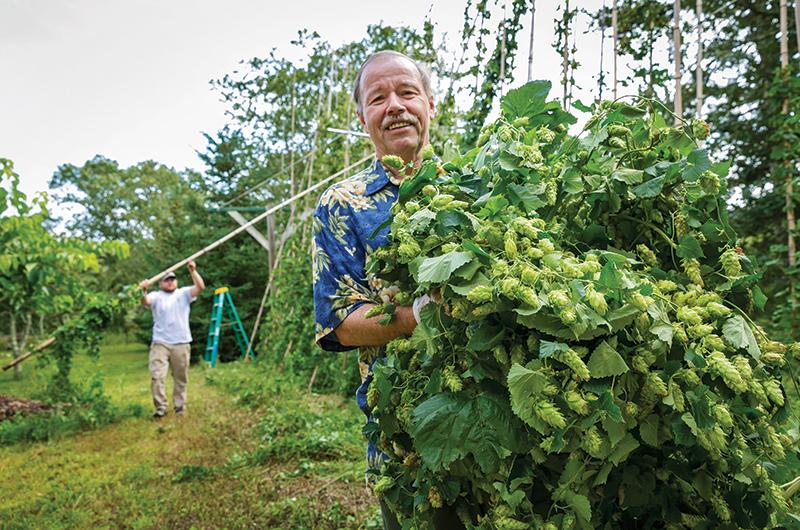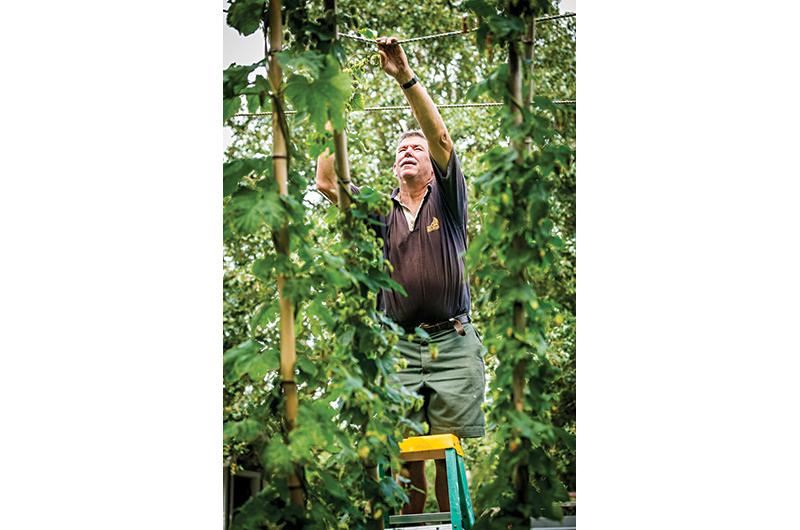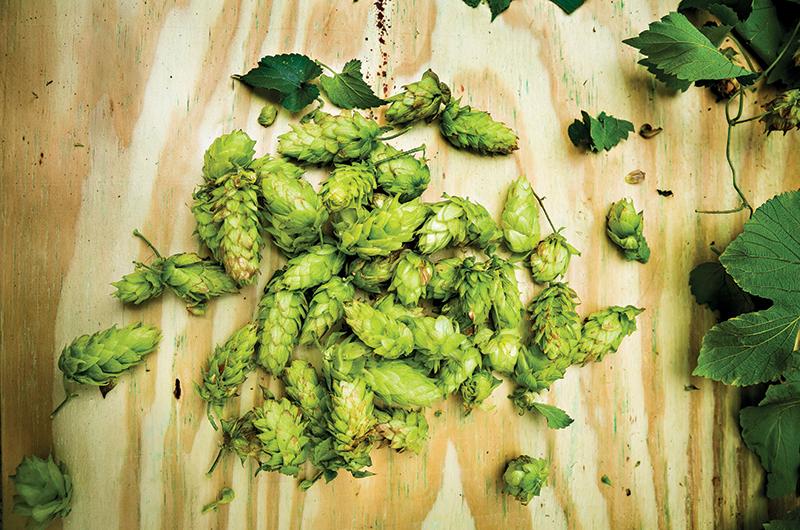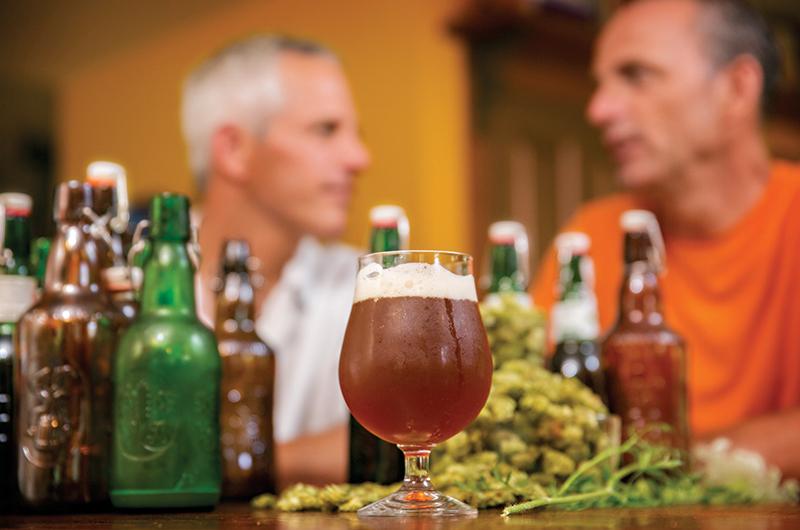The long-range forecast was promising. The long-range forecast was beer. The short-range forecast, however, was for torrential rain.
So it was with a heavy dose of unfounded optimism that the day began with bright, warm sunshine and mostly blue skies over West Tisbury.
When September nears, the volunteer picking crew doesn’t even refer to the buckets and buckets of hops that must be picked in what has become an annual ritual for a merry band of gardeners and beer lovers. They just ask, “What day?”
Ken Rusczyk of Oak Bluffs and Alan Northcott of West Tisbury decide “the day” with some guidance from Neil Atkins, master brewer at Offshore Ale Co., a brewpub in Oak Bluffs. Rusczyk and Northcott are what you might call the CIOs (chief instigating officers) of this whole cockamamie enterprise.

“It has sort of become a cult,” said Rusczyk. “It’s a hop cult. It’s taken on a life of its own. Now people are looking forward to helping. People are coming up asking all the time, ‘When are you going to pick the hops?’”
Somewhere along the second week in September, depending of course on the vagaries of the growing season each year, a group of twenty-five or so perpetually thirsty friends show up on Hopps (you couldn’t make it up) Farm Road in West Tisbury to harvest the hops growing in Northcott’s garden.
His is by far the largest plot but not the only one. Others around the Island grow their own and contribute to the venture. All are grown organically, without pesticides, herbicides, or artificial fertilizer. There is always a fear of the harvest getting wiped out by some sort of pestilence, but to date it hasn’t happened.
Rusczyk has his own little harvest in Oak Bluffs. He is not a conventional kind of guy, so he doesn’t measure time in a conventional way. “It all got started many, many, many brewmasters ago,” he said. “I put it next to my [outdoor] shower and started growing it up the shower.”
Hops don’t grow from seeds. They grow from rhizomes, which look like small logs with shoots growing out of them. Rusczyk had been messing around with rhizomes for several years when, watching CNN one day, he heard about a world-wide shortage of hops. A bad season in Europe and a disastrous warehouse fire in the United States left small brewers scrambling to get enough hops to brew their craft beer.

Unlike the other couple of million people who watched that CNN report, Rusczyk sprang into action. He ordered more rhizomes and decided to begin producing hops in earnest.
“Alan and I thought, ‘We’re going to make some money and make a business out of this,’” Rusczyk said. “We’re not really good businessmen, obviously, because we don’t make any money.”
(Insert drinking up the profits joke here.)
Back on Hopps Farm Road at the picking party, meanwhile, the weather was holding and the pickers working with enthusiasm. Every few minutes Northcott cut more vines, which grow twenty to thirty feet high along bamboo poles. He hauled them over to long tables set up near his house and the pickers dug in, stripping the fragrant hops, which are the flowers of the plant, from the vine.
“We put them in five-gallon buckets and then dump them into bags,” said Rusczyk. “We average about 120 to 130 gallons a year of picked hops, and they all have to be picked by hand. There are machines. We actually checked out a machine that cost $125,000. We figured, ‘Nah, we’re not going to do that.’”

Rusczyk and Northcott are both avid gardeners and raise lots of things besides hops in their garden plots. But they are both fascinated by the hop vines.
“They are so amazing,” said Rusczyk. “They’ll begin to pop out of the ground on a warm day in May. Before we got the bamboo, I was growing them on a rope. I put a mark on the rope with a Magic Marker. Two hours later it would be a quarter-inch higher. They grow so rapidly. They will grow two or three inches a day in May and June.”
“Lots of horse shit,” Northcott said when asked the secret of raising the vines in the relatively inhospitable hop-growing climate of Martha’s Vineyard. “Once they get started, away they go. They grow back every year. If they were a lot of work to grow, I wouldn’t grow them.”
Atkins, the Offshore Ale brewer, was among those picking the hops. Back at the brewpub he had a batch of beer started in a giant copper kettle, just waiting for the ripe hops.
Unlike most craft beers, this one would be brewed as a “wet hop” beer. Large commercial growers dry the hops after they are picked, then pulverize them and mold them into pellets for shipment. For this beer, however, Atkins would incorporate the ripe flowers right into the recipe.

It’s a tricky process. He had invented a couple of contraptions and tweaked the usual brewing operation to accommodate the fresh hops.
“It will be another pale ale, not super bitter, but a nice hop character to it,” Atkins said as he threw another handful in a bucket. “It adds more water to the wort, but it also adds a fresh, grassy flavor to the beer that you wouldn’t get normally. You just allow for the water by making it slightly stronger to begin with. It makes it difficult to use in our system, because it’s not built for flowers, it’s built for pellets. We have to do all sorts of tricks to incorporate these.”
The buckets and bags were filling up with fresh hops when the skies became a little less blue. Within minutes it was apparent that the phrase “wet hop” was going to gain a whole new meaning.
“We were noticing to the west it was getting a little darker and a little darker,” Rusczyk said. “Then about 500 feet away a lightning strike hit and that got everyone’s attention. It doesn’t go boom; it goes sizzle first. You can smell it.”
A few more minutes and the heavens opened in a drenching downpour. But the only picker who left was a faint-hearted magazine writer who feared soaking his electronic recorder. The rest just moved under an outdoor shed. Some even remained at the tables in the deluge. They slogged on until all the hops had been harvested.

“To the credit of our friends,” said Rusczyk, “we had twenty-five people there picking hops in the rain, in the misery sometimes, but we got the job done.”
There is only one rule for the hop picking party, and it is as much an incentive as a rule. Northcott is the enforcer, and he makes no exceptions.
“Nobody drinks beer until the hops are picked,” he said.
Three weeks after the picking party, the helpers, and a fair number of others who heard that the first barrel of Hopps Farm Road Pale Ale had been tapped, gathered at Offshore Ale. There was much praise for brewpub owners Phil and Colleen McAndrews, who could be excused for simply tolerating the boisterous crowd, but instead encouraged and supported the whole crazy hop harvesting endeavor.
Beer flowed out of the taps with abandon, and so did the approval for the work of Atkins. The harvest yielded about 310 gallons of beer from 95 gallons of hops. It would be gone in about fifteen days, much of it consumed by the pickers.
The praise approached worship level.
“Absolutely like sweet nectar of the gods,” said Northcott.
“The taste is perfect,” said Rusczyk. “Everyone who has had it just loves it. This is one of the better ones. Of course, every year I think it’s going to be better than the year before, and it always proves exactly that.”
Northcott was asked where he ranked the beer among all the beers he had ever tasted. His answer was somewhat situational.
“Number one today,” he said.
“You can go through life without a lot of things, but you can’t go without beer,” Rusczyk said.







